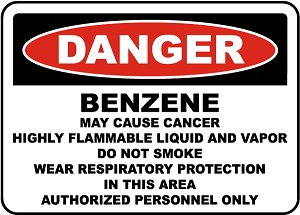Benzene is a highly flammable, colorless liquid that evaporates quickly into the air. At room temperature, it may appear light yellow and has a sweet, gasoline-like odor. Benzene is produced through both natural processes and industrial manufacturing and is widely used in many sectors.

Benzene occurs naturally in crude oil, which is the primary source of modern benzene production. It is also found in products derived from coal and petroleum. Lubricants, plastics, rubbers, dyes, solvents, and many chemical products may contain benzene or be manufactured using it.
OSHA Standard 1910.1028 (Subpart Z) specifically covers benzene and outlines strict requirements to protect workers from exposure.
Health Effects of Benzene Exposure
Benzene is harmful to the eyes, skin, nervous system, respiratory system, and lungs. It is classified as a Group A carcinogen by the Environmental Protection Agency (EPA), meaning it is known to cause cancer in humans. One of the most serious long-term health effects is its association with leukemia and other blood cancers.
Workers in industries that use or produce benzene must read and understand all hazard information on the chemical label and the accompanying Safety Data Sheet (SDS).
OSHA Standard 1910.1028(j)(3)(i) The employer shall provide employees with information and training at the time of their initial assignment to a work area where benzene is present. If exposures are above the action level, employees shall be provided with information and training at least annually thereafter.
How Workers are Exposed to Benzene
Workers can be harmed by exposure to benzene. The level of exposure depends on the dose, duration, work environment, protection, environmental controls and the nature of the work being done.
Individuals employed in industries that manufacture or use benzene may be at risk for harmful exposure levels if proper safety measures are not implemented.
Benzene can be absorbed into the body by inhalation, ingestion, or skin contact. Workers are exposed to benzene primarily by breathing air that contains the chemical.

Short-Term Health Effects of Benzene Exposure
Acute exposure to high levels of benzene can cause:
- drowsiness, dizziness, confusion and headaches
- nausea, irritability, or euphoria
- rapid or irregular heartbeat
- vomiting, tremors and convulsions
- skin redness and blisters
- eye, skin, and respiratory tract irritation
- unconsciousness, or even death
Long-Term Health Effects of Benzene Exposure
Long-term (chronic) inhalation exposure can cause various blood disorders, aplastic anemia, leukemia, and adverse reproductive effects. Long-term exposure to benzene is extremely dangerous and strictly regulated by OSHA.

OSHA Exposure Limits for Benzene
OSHA sets strict limits on exposure to benzene in industrial settings.
Airborne: The maximum time-weighted average (TWA) exposure limit is 1 part of benzene vapor per million parts of air (1 ppm) for an 8-hour workday and the maximum short-term exposure limit (STEL) is 5 ppm for any 15-minute period.
Dermal: Eye contact must be prevented, and skin contact with liquid benzene should be limited.
OSHA Standard 1910.1028(d)(1) The employer shall establish a regulated area wherever the airborne concentration of benzene exceeds or can reasonably be expected to exceed the permissible exposure limits, either the 8-hour time weighted average exposure of 1 ppm or the short-term exposure limit of 5 ppm for 15 minutes.
Controlling Benzene Exposure
Exposure to harmful levels of benzene is controlled by limiting evaporation and preventing splashes and spills. Adequate engineering controls (hoods, canopies, ventilation, process enclosure, etc.) should be implemented and possibly coordinated with the use of PPE, if additional protection is needed.

When engineering controls or work practice controls are not feasible or do not reduce exposure to the permissible level, respirators approved for use with benzene are required. Appropriate protective clothing (boots, gloves, sleeves, aprons, etc.) must be worn to prevent skin contact if working with benzene. If splashes to the eyes or face are a potential hazard, then splash-proof safety goggles or a face shield is required.
Fire and Explosion Hazards of Benzene
Benzene is highly flammable and can ignite at room temperature. Store in tightly closed containers in a cool, well-ventilated area away from sparks or flames. Transfer of benzene from one container to another must be done in a well-ventilated area. Transfer only with grounded, non-sparking equipment.
Benzene vapors are heavier than air so vapors may travel along the ground and ignite somewhere away from where it is being handled. Fire extinguishers must be readily available. Eliminate heat and ignition sources such as sparks, open flames, hot surfaces and static discharge. Post “No Smoking” signs. Prevent accidental contact with incompatible materials.

Warning Signs and Labels for Benzene
Warning signs must be posted at the entrance to areas where exposure to benzene might reasonably be expected to exceed the PEL. All benzene containers should be labeled with the chemical name and hazard information.
OSHA Standard 1910.1028(j)(2)(iii) The employer shall ensure that labels or other appropriate forms of warning are provided for containers of benzene within the workplace. There is no requirement to label pipes.
First Aid for Benzene Exposure
Initiate basic first aid procedures for benzene exposure at work.
If benzene gets splashed into eyes wash out immediately with large amounts of water and if eyes remain irritated or vision becomes blurry, see a doctor as soon as possible.
If benzene gets on the skin then take off the contaminated clothing, thoroughly wash the contacted skin with soap and water, and make sure to wash contaminated clothes before wearing them again.
If large amounts of benzene are inhaled quickly get the exposed person to fresh air quickly, apply artificial respiration if breathing has stopped, and call for medical assistance immediately.
If benzene is swallowed do NOT induce vomiting and call for medical assistance immediately.
OSHA Standard 1910.1028 App A (IV)(C) Never enter any vessel or confined space where the benzene concentration might be high without proper safety equipment and at least one other person present who will stay outside. A life line should be used.
Benzene is a critical industrial chemical but poses serious health and safety risks. By understanding its hazards, complying with OSHA standards, using proper controls, and responding quickly in emergencies, employers and workers can significantly reduce the risk of harmful exposure.

.jpeg)
